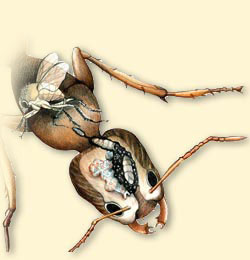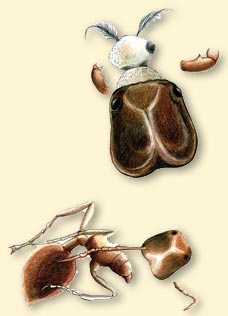Parasitic flies deployed against fire ants

Scientists at the University of Georgia, several other southeastern universities, and the USDA–Agricultural Research Service (Gainesville, Fla.) are releasing parasitic flies with the hope of reducing the fire ant population in the South.
“Fire ants came from Brazil and Argentina,” said Wayne Gardner, an entomologist in UGA’s College of Agricultural and Environmental Sciences. “Unfortunately for us, they didn’t bring their natural enemies with them.” To help address that omission, the scientists are releasing phorid flies (of the family Phoridae) to sites in southeastern states, including Georgia. The flies, which are smaller than gnats, are native to South America.

Illustrations by Wendy Giminski / UGA
The female fly, by stinging the ant, lays an egg inside its body. “When the egg hatches, the larva eats the ant from the inside out, and the ant’s head falls off,” said Gardner.
While Gardner and his UGA colleagues have used natural enemies to fight insect pests for 15 years, “it’s not as easy as finding one and just bringing it here,” he said. “It takes time and resources to go into the natural enemy’s native range, collect samples, and study them to a point where we know it’s safe to introduce the species here.”
The scientists are currently evaluating the effectiveness of nine species of parasitic flies. Each type attacks a different-sized ant—at a particular time of day—and it doesn’t only kill individuals. “The flies also harm fire ant populations by constantly patrolling for ants to sting,” Gardner said. “The ants sense the wing beat of the adult flies, know that their enemies are in the area, and quit foraging.” And when the ants stop foraging, the colony weakens.
Gardner’s team has introduced two species to six sites in central and south Georgia. The researchers are also seeing flies spread into northern, western, and southern Georgia counties from releases made in Tennessee, Alabama, and Florida.
While the scientists don’t expect the
flies to eliminate fire ants completely, they do expect results. “We may
see one mound instead of 10 in a row,” said Gardner.
For more information, contact Wayne Gardner at: wgardner@uga.edu
 |
